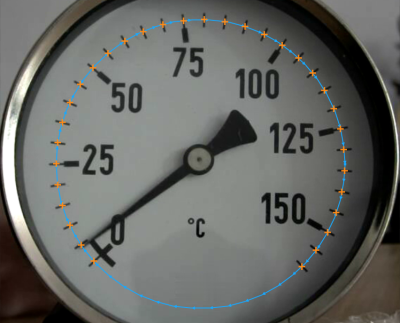You are here: Start » Function Reference » 1D Edge Detection » FisFilter_ScanMultipleRidges
FisFilter_ScanMultipleRidges
This is Filter Equivalent. This function may be present in generated code, but should not be used in hand-written code. CreateScanMap and ScanMultipleRidges should be used instead.
| Header: | FIL.h |
|---|---|
| Namespace: | fis |
Locates multiple dark or bright pixel peaks along a given path.
Syntax
void fis::FisFilter_ScanMultipleRidges ( ScanMultipleRidgesState& ioState, const fil::Image& inImage, const fil::Path& inScanPath, ftl::Optional<const fil::CoordinateSystem2D&> inScanPathAlignment, int inScanWidth, fil::InterpolationMethod::Type inImageInterpolation, const fil::RidgeScanParams& inRidgeScanParams, float inMinDistance, ftl::Optional<float> inMaxDistance, ftl::Optional<const fil::LocalBlindness&> inLocalBlindness, ftl::Array<fil::Ridge1D>& outRidges, ftl::Array<fil::Gap1D>& outGaps, ftl::Optional<fil::Path&> outAlignedScanPath = ftl::NIL, fil::Profile& diagBrightnessProfile, fil::Profile& diagResponseProfile, ftl::Array<fil::Path>& diagSamplingPoints )
Parameters
| Name | Type | Range | Default | Description | |
|---|---|---|---|---|---|
| ioState | ScanMultipleRidgesState& | Object used to maintain state of the function. | |||
 |
inImage | const Image& | Input image to be measured | ||
 |
inScanPath | const Path& | Path along which the scan is performed | ||
 |
inScanPathAlignment | Optional<const CoordinateSystem2D&> | NIL | Adjusts the scan path to the position of the inspected object | |
 |
inScanWidth | int | 1 -  |
5 | Width of the scan field in pixels |
 |
inImageInterpolation | InterpolationMethod::Type | Bilinear | Interpolation method used in extraction of image pixel values | |
 |
inRidgeScanParams | const RidgeScanParams& | RidgeScanParams ( ProfileInterpolation: Quadratic4 SmoothingStdDev: 0.6f RidgeWidth: 5 RidgeMargin: 2 MinMagnitude: 5.0f RidgePolarity: Dark ) | Parameters controlling the ridge extraction process | |
 |
inMinDistance | float | 0.0 -  |
0.0f | Minimal distance between consecutive ridges |
 |
inMaxDistance | Optional<float> | 0.0 -  |
NIL | Maximal distance between consecutive ridges |
 |
inLocalBlindness | Optional<const LocalBlindness&> | NIL | Defines conditions in which weaker edges can be detected in the vicinity of stronger edges | |
 |
outRidges | Array<Ridge1D>& | Found ridges | ||
 |
outGaps | Array<Gap1D>& | Gaps between consecutive ridges | ||
 |
outAlignedScanPath | Optional<Path&> | NIL | Path along which the scan is performed; in the image coordinate system | |
 |
diagBrightnessProfile | Profile& | Extracted image profile | ||
 |
diagResponseProfile | Profile& | Profile of the ridge operator response | ||
 |
diagSamplingPoints | Array<Path>& | Array of paths each one containing the sampling points that contributed to a single value of the extracted profile |
Optional Outputs
The computation of following outputs can be switched off by passing value ftl::NIL to these parameters: outRidges, outGaps, outAlignedScanPath.
Read more about Optional Outputs.
Description
The operation scans the image along inScanPath and detects ridges. Depending on the inRidgeScanParams.ridgePolarity parameter, dark, bright or both ridges will be taken into account.
When the number of ridges to be measured is known, one can use the FisFilter_ScanExactlyNRidges filter.
The optional parameter inScanPathAlignment defines a transform to be performed on the inScanPath so that the actual scan path (outAlignedScanPath) is adjusted to the position of the object, typically detected by one of Template Matching filters.
Note that in case of a scan path which is closed, the parameters controlling the distances between consecutive found objects do not control the distance between the first and the last of the found objects (counting from the beginning of the scan path).
Hints
- Define inRidgeScanParams.RidgePolarity to detect a particular ridge type, and only that type.
- If too few ridges are found, try decreasing inRidgeScanParams.MinMagnitude. Verify this with the values on the diagResponseProfile output.
- If consecutive ridges are very close to each other, change inRidgeScanParams.ProfileInterpolation to Quadratic3.
- Adjust inMinDistance (in pixels) to filter out false ridges that appear in proximity to other ridges.
Examples

FisFilter_ScanMultipleRidges locates the ridges across inScanPath.
Remarks
For more information about local coordinate systems please refer to the following article.
This filter is a part of the 1D Edge Detection toolset. For a comprehensive introduction to this technique please refer to 1D Edge Detection and 1D Edge Detection - Subpixel Precision chapters of our Machine Vision Guide.
See Also
- CreateScanMap – Precomputes a data object that is required for fast 1D edge detection.
- FisFilter_ScanExactlyNRidges – Locates a specified number of the strongest dark or bright pixel peak along a given path.
- FisFilter_ScanSingleRidge – Locates the strongest dark or bright pixel peak along a given path.

